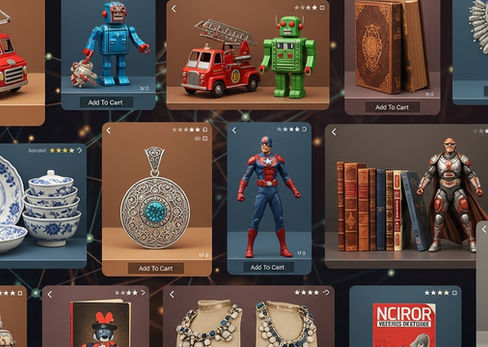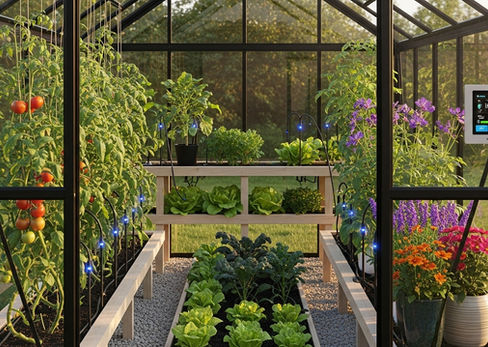Beverage Competition Dynamics: Dutch Bros vs Starbucks
- THE MAG POST

- Aug 13
- 10 min read

The beverage industry is seeing a shakeup, with Dutch Bros making significant strides while Starbucks aims for a turnaround. Dutch Bros' focus on value and customer satisfaction has fueled its growth, contrasting with Starbucks' challenges. As Dutch Bros expands, its success offers insights into thriving amidst competition. Investors are watching closely, as these dynamics shape the future of the coffee market. Dutch Bros' strategy of affordable pricing and customer loyalty seems to be the right recipe for growth in the beverage sector.
The coffee industry is buzzing with activity as Dutch Bros expands while Starbucks navigates a turnaround, highlighting the dynamic nature of beverage competition. Dutch Bros, known for its unique value proposition, is capitalizing on Starbucks' slower recovery, posting impressive same-store sales growth and aggressive expansion plans. This scenario underscores the importance of adaptability and customer-centric strategies in maintaining a competitive edge in the ever-evolving coffee market. The success of Dutch Bros in gaining market share offers valuable insights for other players in the fast-food and beverage sectors looking to thrive amidst intense competition. Understanding these dynamics is crucial for investors and industry observers alike.
Dutch Bros Thrives Amidst Starbucks' Turnaround: A Study in Beverage Competition
Dutch Bros is currently experiencing a period of significant growth, largely attributed to its effective value proposition that resonates well with consumers. The company's focus on providing larger drinks at competitive prices has enabled it to attract and retain a loyal customer base. This strategy contrasts with Starbucks' recent struggles, where the coffee giant has faced challenges in maintaining consistent sales growth. Dutch Bros' success in the face of such competition highlights the importance of understanding and catering to customer preferences. Moreover, the company's strategic expansion into new markets further solidifies its position as a formidable player in the beverage industry. This growth trajectory is not just about increasing store count; it's about building a brand that customers trust and value.
The impressive 6.1% same-store sales growth reported by Dutch Bros in the most recent quarter is a testament to its effective operational strategies and customer engagement initiatives. This growth rate, an acceleration from the previous quarter, demonstrates the company's ability to not only attract new customers but also retain existing ones. The opening of 31 new stores across 13 states further underscores Dutch Bros' ambitious expansion plans and its confidence in the brand's appeal. This strategic growth is crucial for the company to achieve its long-term goal of operating 2,029 stores by 2029. The ability to maintain high growth rates while expanding geographically is a key indicator of a company's sustainable success and its potential for future dominance in the market.
Christine Barone, the CEO of Dutch Bros, emphasized the company's strong value proposition, highlighting that customers appreciate the size and pricing of their drinks. This focus on customer satisfaction is a cornerstone of Dutch Bros' strategy, ensuring that the company remains competitive and appealing in a crowded market. Barone's statement that "We are in growth mode" reflects the company's confidence and its commitment to expanding its footprint across the United States. This growth-oriented mindset is essential for Dutch Bros to continue outperforming competitors and capturing a larger share of the beverage market. The company's leadership is clearly focused on leveraging its strengths to drive sustained growth and profitability.
The fact that Dutch Bros stock has gained over 30% in 2025 is a clear indication of investor confidence in the company's future prospects. This impressive stock performance reflects the market's recognition of Dutch Bros' strong financial health and its potential for continued growth. Investors are likely encouraged by the company's ability to outperform competitors like Starbucks, which has faced its own set of challenges. The positive stock performance also provides Dutch Bros with additional resources and opportunities to further invest in its expansion plans and enhance its customer offerings. This virtuous cycle of growth and investment is a key driver of the company's long-term success.
Analyzing Dutch Bros' Competitive Edge in the Beverage Market
Dutch Bros' competitive edge is significantly enhanced by its ability to maintain momentum even as Starbucks attempts to stabilize its operations. This resilience is a key factor in the company's continued success and its ability to attract investors. William Blair analyst Sharon Zackfia noted that Dutch Bros’ robust second quarter should dispel the narrative that a stabilizing competitor in Starbucks would eat into Dutch’s momentum. This observation highlights the strength of Dutch Bros' brand and its ability to differentiate itself in the market. The company's focus on customer service, unique drink offerings, and a strong community presence all contribute to its competitive advantage.
The broader competition in the fast-food space, with companies like Yum Brands' Taco Bell and McDonald's expanding their beverage menus, underscores the increasing importance of beverages as a key revenue driver. Dutch Bros' ability to thrive in this competitive environment demonstrates its strategic acumen and its understanding of market trends. By focusing on quality, value, and customer experience, Dutch Bros has carved out a unique position for itself in the market. This strategic positioning is crucial for the company to continue attracting customers and maintaining its growth trajectory. The competitive landscape is constantly evolving, and Dutch Bros' adaptability is a key factor in its long-term success.
Christine Barone's assertion that Dutch Bros is "no stranger to lots of competition" reflects the company's long history and its experience in navigating a dynamic market. Having been around since 1992, Dutch Bros has developed a deep understanding of the beverage industry and the strategies required to succeed. The company's roots in the Pacific Northwest have instilled a strong sense of community and customer loyalty, which are key differentiators. Barone's acknowledgment that "There will always be new competitors coming into the market" underscores the company's proactive approach to competition and its commitment to continuous improvement.
The contrasting performance between Dutch Bros and Starbucks, with the former experiencing growth and the latter facing sales declines, highlights the importance of strategic agility and customer-centricity. Dutch Bros' growth in the second quarter stands in stark contrast to Starbucks' six straight quarters of US same-store sales declines, including a 2% drop in the latest quarter. This divergence in performance underscores the challenges that Starbucks faces in its turnaround efforts and the opportunities that Dutch Bros has seized. The ability to capitalize on a competitor's weaknesses is a hallmark of a successful company, and Dutch Bros has demonstrated this ability effectively.
TD Cowen analyst Andrew Charles noted that "When you look at the same-store sales, plus the store growth, it's clear that Dutch Bros is gaining share from Starbucks." This observation reinforces the idea that Dutch Bros is not just growing in isolation but is actively taking market share from its larger competitor. This market share gain is a significant achievement and reflects the effectiveness of Dutch Bros' strategies. The company's ability to attract customers away from established brands like Starbucks is a testament to its strong value proposition and its ability to connect with consumers on a personal level.
Starbucks' Turnaround Efforts and the Impact on Beverage Competition
Starbucks' ongoing turnaround efforts are closely watched by industry analysts and investors, as the company seeks to regain its competitive edge in the beverage market. The appointment of Brian Niccol as CEO in August 2024 signaled a renewed focus on strategic initiatives aimed at revitalizing the brand. Niccol's acknowledgment that the company has "made progress" on its value proposition over the last three quarters indicates that Starbucks is taking steps in the right direction. However, the company still faces significant challenges in fully executing its turnaround plan and regaining its lost market share. The success of Starbucks' turnaround will have a significant impact on the overall competitive landscape.
Brian Niccol's emphasis on the need to continue efforts to improve Starbucks' value proposition highlights the importance of customer perception and pricing strategies. Starbucks has faced criticism for its higher prices compared to competitors like Dutch Bros, and addressing this issue is crucial for attracting and retaining customers. The company's efforts to enhance its loyalty program, introduce new menu items, and improve the overall customer experience are all part of its strategy to regain its competitive edge. The ability to effectively communicate and deliver on its value proposition will be a key determinant of Starbucks' success.
Baird analyst David Tarantino's upgrade of Starbucks to Outperform from Neutral reflects a growing optimism about the company's turnaround prospects. Tarantino's expectation that "visibility" of its turnaround plan will "become increasingly clear over the next several quarters" suggests that the market is starting to see tangible progress. This upgrade is a positive signal for investors and could lead to increased confidence in Starbucks' ability to rebound. However, the company still needs to demonstrate consistent improvement in its financial performance and customer satisfaction to fully validate this optimism.
The fact that Starbucks stock is up 2% this year indicates that the market is cautiously optimistic about the company's future. While this increase is modest compared to the gains made by Dutch Bros, it reflects a degree of confidence in Starbucks' turnaround efforts. The stock's performance is likely influenced by a variety of factors, including overall market conditions, investor sentiment, and the company's financial results. As Starbucks continues to implement its strategic initiatives, its stock performance will be a key indicator of its progress and its ability to regain its competitive position.
The competitive dynamics between Dutch Bros and Starbucks underscore the importance of adaptability and innovation in the beverage market. While Starbucks is working to address its challenges and implement its turnaround plan, Dutch Bros is capitalizing on its strengths and expanding its market share. This ongoing competition benefits consumers by providing them with more choices and driving companies to improve their offerings. The beverage market is constantly evolving, and companies that can adapt to changing consumer preferences and competitive pressures are best positioned for long-term success.
Strategies for Sustaining Growth in the Competitive Beverage Industry
Sustaining growth in the competitive beverage industry requires a multifaceted approach that encompasses strategic innovation, customer engagement, and operational excellence. Companies must continuously adapt to changing consumer preferences, technological advancements, and market dynamics to maintain their competitive edge. Investing in research and development to create new and innovative products is crucial for attracting and retaining customers. Additionally, building strong relationships with customers through personalized marketing and exceptional service can foster loyalty and drive repeat business.
Effective customer engagement strategies are essential for building brand loyalty and driving sales growth. Companies can leverage social media, loyalty programs, and personalized marketing to connect with customers on a deeper level. Understanding customer preferences and tailoring offerings to meet their needs is crucial for creating a positive customer experience. Additionally, providing excellent customer service and addressing customer concerns promptly can enhance brand reputation and foster long-term relationships. Customer engagement is not just about marketing; it's about building a community around the brand.
Operational excellence is a key driver of profitability and sustainable growth in the beverage industry. Streamlining operations, reducing costs, and improving efficiency can enhance a company's financial performance and enable it to invest in growth initiatives. Implementing technology solutions to automate processes, optimize supply chains, and improve inventory management can drive significant cost savings. Additionally, investing in employee training and development can enhance productivity and improve the quality of products and services. Operational excellence is about doing more with less and creating a culture of continuous improvement.
Strategic partnerships and collaborations can provide companies with access to new markets, technologies, and resources. Collaborating with other companies in the beverage industry or related sectors can create synergies and enhance competitive advantage. For example, partnering with a technology company to develop a mobile app for ordering and loyalty programs can enhance customer engagement. Additionally, collaborating with a distribution company can expand market reach and improve supply chain efficiency. Strategic partnerships are about leveraging the strengths of multiple organizations to achieve common goals.
The ability to adapt to changing market dynamics and consumer preferences is crucial for long-term success in the beverage industry. Companies must continuously monitor market trends, analyze competitor strategies, and adjust their own plans accordingly. Being proactive and anticipating future changes can enable companies to stay ahead of the curve and capitalize on new opportunities. Adaptability is not just about reacting to change; it's about anticipating it and preparing for it. Companies that can embrace change and innovate are best positioned for sustained growth and profitability.
The Future of Beverage Competition: Trends and Predictions
The future of beverage competition is likely to be shaped by several key trends, including increasing consumer demand for healthier options, the growing importance of sustainability, and the continued rise of digital technologies. Companies that can effectively address these trends and adapt their strategies accordingly will be best positioned for long-term success. The beverage industry is constantly evolving, and companies must be proactive and innovative to stay ahead of the curve. Understanding these trends is crucial for making informed decisions and developing effective strategies.
Consumer demand for healthier beverage options is on the rise, driven by increasing awareness of the health risks associated with sugary drinks and artificial ingredients. Companies are responding by developing new products that are lower in sugar, calories, and artificial additives. This trend is likely to continue, with consumers increasingly seeking out beverages that are both delicious and nutritious. The ability to offer healthier options will be a key differentiator in the future beverage market. Companies that can innovate and create products that meet these demands will be well-positioned for growth.
Sustainability is becoming an increasingly important factor for consumers, who are seeking out brands that are environmentally responsible. Companies are responding by implementing sustainable practices throughout their supply chains, reducing their carbon footprint, and using eco-friendly packaging. This trend is likely to continue, with consumers increasingly willing to pay a premium for sustainable products. The ability to demonstrate a commitment to sustainability will be a key differentiator in the future beverage market. Companies that can effectively communicate their sustainability efforts and demonstrate their positive impact on the environment will be well-positioned for success.
Digital technologies are transforming the beverage industry, enabling companies to connect with customers in new and innovative ways. Mobile apps, social media, and e-commerce platforms are becoming increasingly important for marketing, sales, and customer engagement. Companies are leveraging these technologies to personalize their offerings, provide targeted promotions, and build stronger relationships with customers. The ability to effectively utilize digital technologies will be a key differentiator in the future beverage market. Companies that can embrace these technologies and integrate them into their overall strategy will be well-positioned for growth.
The competitive landscape of the beverage industry is likely to become even more intense in the coming years, with new players entering the market and existing companies expanding their product offerings. Companies will need to be agile, innovative, and customer-centric to succeed in this environment. The ability to adapt to changing market dynamics, leverage new technologies, and build strong relationships with customers will be crucial for long-term success. The future of beverage competition will be shaped by companies that can effectively navigate these challenges and capitalize on new opportunities.






















































Comments